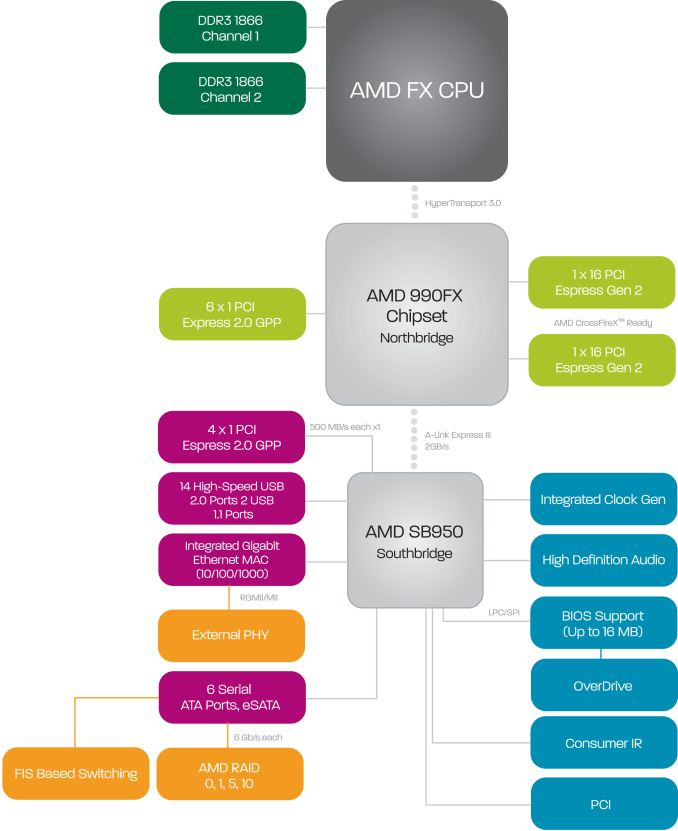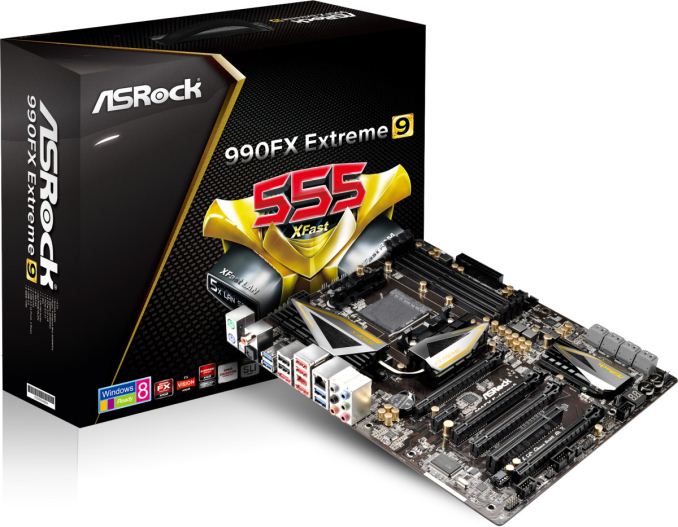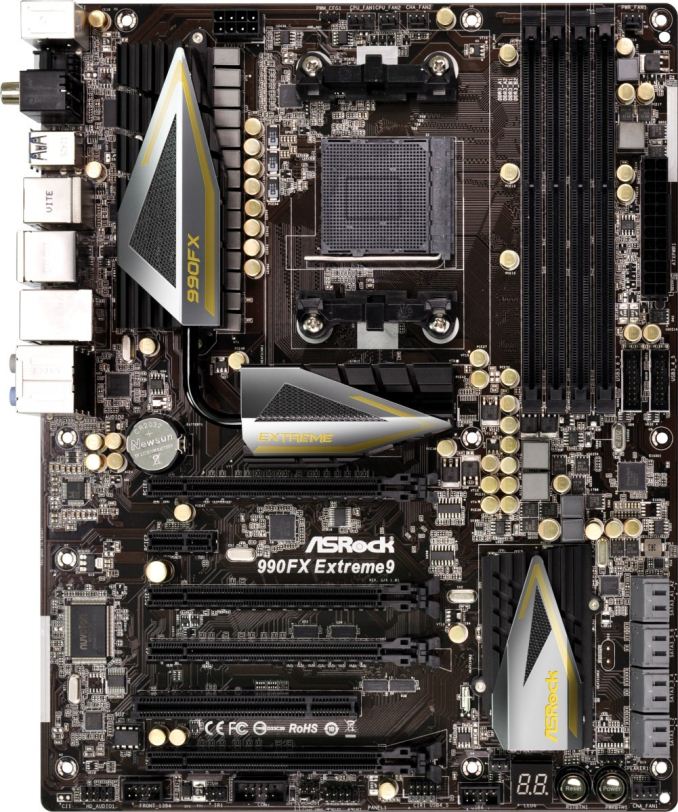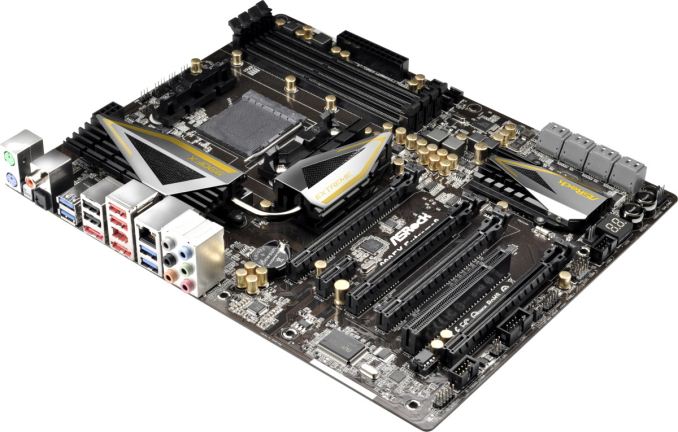AMD’s 5 GHz Turbo CPU in Retail: The FX-9590 and ASRock 990FX Extreme9 Review
by Ian Cutress on August 9, 2014 8:00 AM ESTFor new users to the PC industry, or those that migrated towards newer APU platforms, it is worth going back and recalling the AM3+ socket with the 990FX chipset. When the platform was released, it offered several advantages that Intel lacked at the time: a full set of SATA 6 Gbps ports was the main advantage which took Intel another two generations to offer. The chipset, with the right CPU, also offered substantially more PCIe lanes than the mainstream Intel parts which were similarly priced. While the user could have sixteen PCIe 2.0 lanes from an Intel CPU for graphics coupled with eight PCIe 2.0 lanes from the chipset, AMD users had 32 PCIe 2.0 lanes from the CPU for graphics, another six PCIe 2.0 x1 lanes for controllers and four PCIe 2.0 x1 lanes from the chipset. This gave the AMD motherboard manufacturers more bandwidth to add extra ports or adjust their PCIe layout for graphics. Note that this is the latest AMD platform to support SLI, rather than the newer FM1/FM2 platforms that do not.
There are a few limitations on the 990FX chipset worth mentioning. When this motherboard we are testing today was released, PCIe 3.0 was gaining momentum. The only way to add PCIe 3.0 to these motherboards was to integrate a PLX chip between the Northbridge and the GPUs which gave PCIe 3.0 capabilities between the GPUs, but it still limited data transfer between the PLX chip and the CPU to PCIe 2.0. The other limitation was one of cost. AMD platforms have historically been low cost markets, at least for end users, which correlates to a reluctance to expand spending on motherboards. This reduces the market for high end motherboard solutions which might incorporate extra features and controllers, and as a result many AM3+ motherboards were aimed at price/performance rather than feature set.
The ASRock 990FX Extreme9 sits near the top of the stack for feature set, and currently retails for $170. To put that into perspective, we discuss $170 motherboards for Intel’s latest chipsets as a mid-range point rather than the high end.
Also worth noting that because our last 990FX reviews were with the FX-8150 processor, in order to compare to historical data we also used the Extreme9 with the FX-8150 for comparison points.
ASRock 990FX Extreme9 Overview
Visual Inspection
Taking the motherboard out of the box for the first time and there are several items worth noting. Firstly the extended heatsink which covers the 12+2 phase power delivery to the side of the socket and the North Bridge just below the socket. ASRock has placed all the power delivery chokes in a line, and uses a CHIL8328 IC for a digital design. This PWM controller powers 6-8 phases, and thus the system uses multiplexing to get the desired 12 for the CPU voltage.
The socket area has four fan headers within immediate reach – two CPU and one chassis header directly above the socket, and a 3-pin PWR header to the top right of the DRAM slots. The other two fan headers on the motherboard are located at the bottom, one to the left of the 2-digit debug and the other to the right of the power/reset buttons. The socket area uses a low heatsink profile combined with a gap to the DRAM that should allow for large air coolers to be used.
The DRAM slots use double sided latch mechanisms and there is ample space to the first major PCIe slot. At the bottom of the DRAM slots, to the right, are two USB 3.0 headers from an Etron EJ188H controller. At the time this motherboard was made, a chassis may have had one USB 3.0 header, and thus ASRock also includes a USB 3.0 panel in the box.
Underneath this are eight SATA 6 Gbps ports, the top two from an ASMedia ASM1061 controller followed by six from the south bridge. In this situation, with an additional controller, I would have preferred if ASRock had used a different color for the ASMedia ports. Below these is a fan header, the power and reset buttons, and the two-digit debug.
At the bottom of the motherboard is an IEEE1394 header, a COM header, two USB 2.0 headers, an IR header and the front panel headers. Above this is the odd PCIe layout, which combines the 32 PCIe 2.0 lanes from the north bridge with another PCIe 2.0 x4.
The layout is such that the top PCIe slot is an x16, followed by an x1. The second full length slot is a PCIe 2.0 x4, followed by another PCIe 2.0 x16. This slot shares bandwidth with the bottom PCIe slot, whereby if the bottom is populated, they both go to PCIe 2.0 x8. There is also a PCI slot near the bottom.
This means:
Configuration 1: x16/x1/x4/x16/PCI/-
Configuration 2: x16/x1/x4/x8/PCI/x8
Having this layout allows the user to equip the board with three GPUs in the first, third and fourth full length slots. If they are double slot cards, the PCIe 2.0 x4 is left vacant for a sound card, network card, RAID card or other PCIe device. It is worth noting that in terms of audio, ASRock has equipped this motherboard with a Realtek ALC898 codec.
The rear panel uses two PS/2 ports, one for mouse and one for keyboard, followed by a ClearCMOS button and SPDIF outputs. The four blue USB 3.0 ports are powered by another Etron EJ188H controller, and the panel also has four USB 2.0 ports with two eSATA 6 Gbps ports. The IEEE1394 port on the rear is perhaps one of the last consumer oriented motherboard to have this port pre-installed. The Intel NIC on the rear IO might seem a little strange on an AMD motherboard, but this is one of the top line 990FX solutions. The audio jacks round off the set.
Board Features
| Board Features | |
| Price | US (Newegg) |
| Size | ATX |
| CPU Interface | Socket AM3+ |
| Chipset | 990FX + SB950 |
| Memory Slots |
Four DDR3 DIMM slots supporting up to 32 GB Up to Dual Channel, 1066-2450 MHz |
| Video Outputs | None |
| Onboard LAN | Intel 82583V |
| Onboard Audio | Realtek ALC898 |
| Expansion Slots |
3 x PCIe 2.0 x16 (x16/x16/- or x16/x8/x8) 1 x PCIe 2.0 x4 1 x PCIe 2.0 x1 1 x PCI |
| Onboard SATA/RAID |
6 x SATA 6 Gbps (Chipset), RAID 0,1,5,10 2 x SATA 6 Gbps (ASMedia ASM1061) |
| USB 3.0 |
4 x Rear USB 3.0 (Etron EJ188H) 2 x USB 3.0 Headers (Etron EJ188H) |
| Onboard |
8 x SATA 6 Gbps Ports 2 x USB 3.0 Headers 2 x USB 2.0 Headers 6 x Fan Headers 1 x COM Header Power/Reset Switches Dr. Debug LED Front Panel Connector Front Audio Connector |
| Power Connectors |
1 x 24-pin ATX 1 x 8-pin CPU |
| Fan Headers |
2 x CPU (4-pin, 3-pin) 3 x CHA (4-pin, 2x 3-pin) 1 x PWR (3-pin) |
| IO Panel |
1 x PS/2 Keyboard 1 x PS/2 Mouse 4 x USB 2.0 4 x USB 3.0 2 x eSATA 6 Gbps 1 x IEEE1394 1 x Intel NIC Clear CMOS Switch Audio Jacks |
| Warranty Period | 3 Years |
| Product Page | Link |
If we were making a high end AMD motherboard for 2014, the extra lanes would be perfect for PCIe storage. Pile on a SATA Express and M.2 x4 slot without losing lanes to other functions. Some native USB 3.0 would be nice, or 3.1 via controllers. PCIe 3.0 support would be a must of course, along with a Realtek ALC1150 or more advanced audio codec. ASRock’s latest motherboards have featured a water-proof/superhydrophobic coating, or small LCD panels to aid in overclocks, which might be something in AMD meets 2014.















146 Comments
View All Comments
Budburnicus - Wednesday, January 14, 2015 - link
Umm, it is QUITE possible to get a SandyBridge to 5 GHz, in fact I have my i7-2600K rock stable at 4.7 GHz (where my Haswell i7-5930k is 4.4) - and it TOTALLY SPANKS this POS FX 9590! Less power, same clock speed, MUCH higher performance!AT is being TOO EASY on AMD, not too harsh! This CPU is not a "win" in any sense!
bebimbap - Saturday, August 9, 2014 - link
No matter what any one that loves this FX-9590 says, this processor is just an exercise in gluttony, and devolution.I have been spoiled by computer evolution. coming from the commodore/Macintosh/SX286 days. you appreciate a few things. such as noise/heat/size reduction of modern systems.
50-80w cpus are quiet, compared to the pentium4 days.... or Hairdryer days...
SSDs are silent,
modern HDDs are basically silent, compared to 40MB drives and 3.5/5.25 floppies and don't forget the stack of floppies you had in the drawer instead of a single USB stick.
modern gpus not oc'd are quiet, still remember the hiss of my gforce3Ti
CRTs - actually have a noise when you turn them on, some buzz when in use... and don't forget the size.
case- you either had a monster of a case that would break your table if you put it on it, or a fugly thing that you wanted to hide under the table.
overall the heat produced compared to a 19" crt + pentium4/thoroughbred + 9800XT compared to a modern system also let you get rid of the window AC unit reducing a lot of noise.
so i am spoiled because i can now have a system where i'm not sweating like a pig and going deaf while playing my favorite game or browsing the web. I don't need a 1000w speaker system to hear the gunshots clearly over my cpu/gpu/psu fans or window AC unit.
I no longer need a computer be a 4in1 device that acts as a heater, a LOUD white noise generator, an air filter, and computer. It should be similar to a BMW-M5, everyday comfort and driveability but grunt when you want it, but of course with better fuel economy.
Leyawiin - Saturday, August 9, 2014 - link
This article makes me feel good about the FX-6300 @ 4.5 Ghz I have. At least with the games they chose to benchmark I'm doing fine.siberus - Saturday, August 9, 2014 - link
Any chance we could get some testing with radeon gpu's using mantle ? :) would be pretty neat to see how some of the older/lower tiered cpu's break down. Unless you guys have done something like that already in another article then I apologize for asking.monstercameron - Saturday, August 9, 2014 - link
this cpu just chew through integer workloads, faster than a 4770k, where it fails is every thing else. I reckon a well optimized program written directly[fma?] for it would haul ass!resination - Saturday, August 9, 2014 - link
This is THE processor for the "rolling coal" set.CSammy - Saturday, August 9, 2014 - link
Pathetic. The cover might as well be Intel pissing on this AMD processor, because that is quite literally the truth in nearly every single aspect.TiGr1982 - Saturday, August 9, 2014 - link
Note that there is no recent Devil's Canyon Core i7-4790K here - this one, being around 13% faster than i7-4770K in CPU-bound tasks, would make the FX to look even less relevant.TheinsanegamerN - Saturday, August 9, 2014 - link
"AMD clearly does care about the performance market"yeah, thats why they couldnt even be bothered to use the new kaveri cores, instead rehashing an old piledriver cpu with higher clocks and a TDP that puts netburst to shame. all the while, performing sligtly slower then a intel cpu with a third the tdp and running 1.5 GHz slower.
They care about the performance market so much, that they put this chip on the 3 year old AM3+ platform, rather than the new FM2+ platform, just so we can use old chipsets with feature sets from 2011.
And it costs as much as a core i7.
CLEARLY, AMD still cares about the performance market.
TiGr1982 - Saturday, August 9, 2014 - link
I perfectly understand your sarcasm :)I guess, it was something like that: AMD did not and does not have the resources and/or desire to invest into pure many-module CPUs beyond Piledriver FX CPU. So, from the engineering standpoint, they stopped there.
But then the marketing stepped in and said: "We need a faster CPU to brag. Because we aren't developing a new one, can you boost the current one?" And the engineering team said "Yes... Okay...". And they did. :)